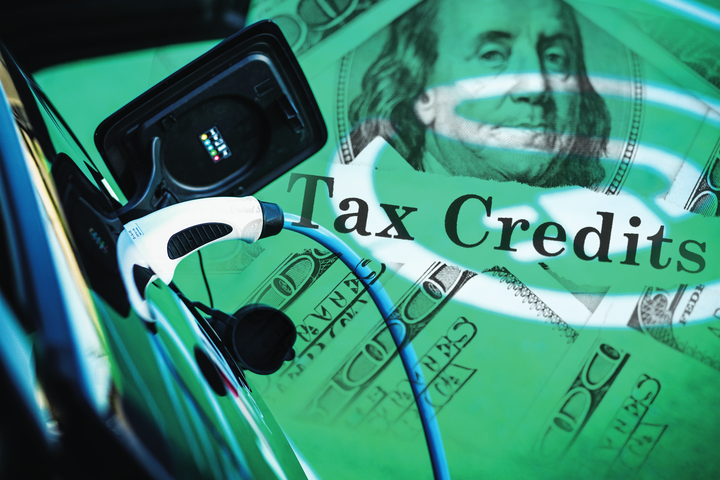
The Inflation Reduction Act will ultimately replace the old $7,500 EV tax credit with a new, more complicated methodology designed to incentivize domestic EV production and reduce the country’s reliance on foreign supply chains.
Photo: Getty Images
The Inflation Reduction Act of 2022 was signed into law by President Biden on Aug. 16, 2022. It is a massive piece of legislation comprised of 725 pages. Altogether, this gigantic bill authorizes expenditure of $740 billion in a variety of areas ranging from price negotiations for prescription drugs to the hiring of 87,000 new IRS agents, but what’s of keen interest to the auto industry is that out of this $740 billion, the law earmarks about $369 billion for climate-related and alternative energy initiatives, and in particular it creates a new set of rules on the issuance of tax credits to purchase new and used EVs.
The legislative was co-authored by Senator Joe Manchin of West Virginia and Senator Chuck Schumer of New York, who is also the majority leader of the U.S. Senate. Senator Manchin was the driving force for the new sourcing requirements needed to determine an EV’s eligibility to take advantage of the federal tax credits.
Many who are familiar with the new law say that it is confusing, however, and that the new sourcing requirements creates tougher-to-meet eligibility criteria.
In essence, the Inflation Reduction Act will ultimately replace the old $7,500 EV tax credit with a new, more complicated methodology designed to incentivize domestic EV production and reduce the country’s reliance on foreign supply chains.
Assembled in North America
One key provision of the new law is that EVs are only eligible for the tax credit if they are assembled in North America. In addition, the law stipulates additional new eligibility restrictions based on the vehicle’s MSRP, a buyer’s income, and the sourcing of components and rare earth metals to manufacture the batteries, all of which will take effect Jan. 1, 2023.
The new law allows OEMs to offer a tax credit if an EV meets certain conditions:
- One condition is that they will need to be built with minerals and rare earth metals that are extracted or processed in a country where the U.S. has a free trade agreement. The U.S. does not have a free trade agreement with China, for example, which is the No. 1 exporter of these rare earth metals. But the U.S. does have free trade agreements with other exporters of rare earth metals such as Australia, South Korea, and Canada, along with 17 other countries. So to be eligible for the EV tax credits, OEMs who have supply chains emanating from China will have to reconfigure their sourcing agreements to other countries with which the U.S. maintains free trade agreements.
- A second condition is that for an EV to be eligible for tax credits, it needs to be powered by a battery that includes a large percentage of components that are manufactured or assembled in North America.
So let’s break this down further.
The assembly requirements stipulated by the Inflation Reduction Act will actually reduce the number of EVs eligible for the tax credits from 72 models down to only 22 models, according to estimates released the federal government.
Battery Assembly Requirements
Another important point to consider about the 2022 and 2023 eligible models for the federal tax credit is that while these vehicles meet the North American assembly requirements, it is still unclear whether they will still be eligible in 2023 when the new rules on battery content and retail price take effect.
OEMs that rely heavily on Chinese-made batteries for their current EVs have complained it will be impossible to meet these mineral sourcing requirements when the new rules become effective at the start of calendar-year 2023. If an OEM is unable to change its battery sourcing, then its EVs will be disqualified from receiving an EV tax credit.
As I stated earlier, about 22 models meet the North American final assembly requirement and therefore still qualify for EV tax credits of up to $7,500 until the end of calendar-year 2022. However, the number of eligible models will most likely be further reduced when these new sourcing requirements for batteries take effect at the start of calendar-year 2023.
Under the new law, consumers can claim the EV tax credit on the purchasing year’s tax returns when filed or, starting in 2024, the credit can be transferred to the dealer at the point of sale.
On the positive side, the Inflation Reduction Act expands the EV tax credit to allow fuel-cell vehicles to qualify and it eliminates the termination of EV credits after a manufacturer sells more than 200,000 EVs, which was a requirement in the prior law and currently impacts General Motors and Tesla.
Unintended Consequences
The revised eligibility requirements for an EV tax credit broaches a much bigger question: If an EV isn’t eligible for tax credits, how will its total sales be impacted? Will customers still buy it or instead purchase an alternative EV that is eligible for tax credits?
Could there be an unintended consequence of this law? Will EV adoption be slowed if many won’t qualify for the tax credit? The reality is that without the EV tax credit, there is a significant disparity in price between a comparable ICE vehicle and a battery-electric vehicle, which may force consumers to have no choice but to acquire an ICE vehicle simply because they can’t afford the higher EV price.
These are all legitimate questions and it is still too early to definitively determine the impact of the new EV tax credit restrictions on end-user demand and buying inclinations. Only time will tell, and there is nothing to preclude OEMs whose EVs do not qualify for the tax credit from offering their own fleet incentives to stimulate sales.
IRS Preliminary Guidance
The IRS has issued preliminary guidance on the transition from the old EV tax credit to the new methodology to receive an EV tax credit.
According to the IRS, EV buyers can still qualify for the previous $7,500 tax credit—with no restrictions on MSRP, buyer’s income, battery content, or origin of final assembly—if they have a written binding contract to purchase a qualifying vehicle before Aug. 16, which is the effective date of the Inflation Reduction Act.
I’m sure once this new law is fully analyzed by the automotive industry, there will be many more gray areas that come into question. As they say, the devil is the details.
For GREAT deals on a new or used Mercedes check out Mercedes of Flagstaff TODAY!

